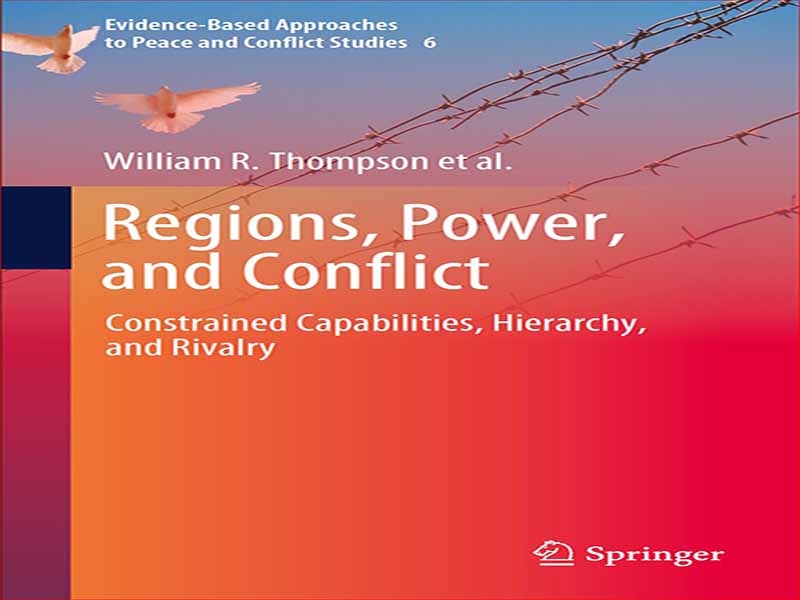- عنوان کتاب: Regions, Power, and Conflict
- نویسنده: William R. Thompson
- حوزه: روابط بین الملل
- سال انتشار: 2022
- تعداد صفحه: 295
- زبان اصلی: انگلیسی
- نوع فایل: pdf
- حجم فایل: 8.80 مگابایت
این جلد بر مطالعه روابط بین الملل منطقه ای تمرکز دارد. بیشتر فصل ها به چندین منطقه نگاه می کنند و از این نظر مقایسه ای هستند. برخی از فصلها بر یک منطقه متمرکز میشوند، اما به گونهای که خود را به مقایسههای آینده میرساند. چرا باید این مناطق را مطالعه کنیم؟ یکی از دلایل این است که محققان روابط بین الملل سطوح تحلیل مونادیک (تک دولت)، دوتایی (جفت دولت) و سیستمیک (اعم از همه دولت ها یا دولت های نخبه) را بررسی کرده اند. هر یک از این رویکردها دستاوردهایی دارد. محدودیت هایی نیز وجود دارد. با این حال، در نهایت، دشوار است که ادعا کنیم هر یک از این رویکردها تنها راه است. تحلیل منطقه ای برای حذف سایر رویکردها طراحی نشده است. در عوض، ایده تکمیل آنها است. به استثنای قدرت های بزرگ، دولت های مونادیک و جفت دولت های دوتایی در زمینه های منطقه ای فعالیت می کنند. به ندرت، آنها در تعاملات خود از مرزهای منطقه ای فراتر می روند. تعاملات سیستمی می توانند واقعاً کل نگر باشند، اما اغلب آنها تعاملات منطقه ای را پنهان می کنند. به عنوان مثال، جنگ های جهانی را در نظر بگیرید. ما آنها را جنگ جهانی می نامیم زیرا مشارکت گسترده و درگیری گسترده است. با این حال، حتی این جنگ های جهانی نیز تمایل دارند به طور انتخابی بر مناطق متمرکز شوند. جنگ جهانی دوم ممکن است یک جنگ محدود به دو منطقه باشد: اروپا و شمال آفریقا و شرق آسیا – یعنی در بهترین حالت سه منطقه. زمانی که آلمان به ایالات متحده اعلان جنگ کرد، اوضاع پیچیده تر شد. تئاترهای منطقه ای در یک جنگ بسیار بزرگ ادغام شدند. با این حال، نبرد به شدت منطقه ای باقی ماند. مشاهدات مشابهی را می توان در رابطه با جنگ های جهانی قبلی انجام داد. بنابراین، یک دلیل این است که فعالیت های زیادی در روابط بین الملل در داخل مناطق صورت می گیرد. دلیل دوم این است که تحلیل های منطقه ای می توانند تحلیل های محدودتر را تکمیل و تکمیل کنند. وقتی دو کشور در خاورمیانه با هم برخورد می کنند، زمینه منطقه ای هرگز غایب نیست. درگیریها در منطقهای مانند خاورمیانه دارای پیشایند و پیامدهایی در منطقه بزرگتری است که در آن رخ میدهد. دقیقاً همین اظهارات را می توان در مورد همکاری یا درگیری در شرق آفریقا یا آسیای جنوب شرقی بیان کرد. چرا نمیدانیم که چگونه میتوان زمینه بزرگتر را وارد تحلیل کرد؟ دلیل سوم برای تحلیل منطقه ای دو بعد دارد. مناطق مکان های بسیار ناهمگن هستند. هیچ دو منطقه ای دقیقاً مشابه به نظر نمی رسد. بخشی از دلیل این امر این است که آنها وابستگی های مسیر بسیار متفاوتی دارند. اروپای غربی دارای سابقه طولانی جنگ طولانی بین چندین دولت است که پس از صد سال نبرد به تعداد بسیار کمتری از ایالت ها کاهش یافت. آسیای شرقی با نوسانات در تمرکز و عدم تمرکز مشخص می شود، به طوری که اندازه چین و حکومت آن بر این اساس در نوسان است. مناطق جنوب صحرای آفریقا نسبت به منطقه پرجمعیتتر اروپای غربی دارای سابقه کم جمعیتی و در نتیجه شهرنشینی کمتر و دیدگاه متفاوتی نسبت به ارزش قلمرو هستند. آمریکای جنوبی سابقه طولانی وابستگی به صادرات ابتدا به بریتانیا و سپس به ایالات متحده دارد. احتمالاً، این وابستگیهای مسیر میتوانند در فعالیتهایی که در دوره معاصر مدلسازی میکنیم، تفاوت ایجاد کنند. با این حال، به ندرت، ما آنها را فراتر از افزودن یک ابزار باینری که ثبت می کند آیا یک کشور در یک منطقه خاص است یا نه، کنترل می کنیم. وقتی این کار را انجام میدهیم، مشخص نمیکند که برای چه وابستگیهای مسیری تلاش میکنیم کنترل کنیم – و معمولاً وقتی متغیرهای منطقهای در معادلات مهم ظاهر میشوند توجه زیادی به آنها نمیکنیم. بنابراین، یک دلیل اضافی این است که وقتی صرفاً یک کنترل منطقهای باینری را اختصاص میدهیم، کار ضعیفی در گرفتن وابستگیهای مسیر انجام میدهیم. اگر آن را با یک نام مناسب یا مکان جغرافیایی صدا کنیم، به احتمال زیاد وابستگی های چند مسیر را با هم ترکیب می کنیم. وقتی می گوییم فعالیت خاورمیانه، غرب آفریقا یا آمریکای مرکزی است، منظورمان چیست؟ علاوه بر این، در مقطعی باید مشخص کنیم که نام مکان های مناسب به چه معناست تا بتوانیم آنها را با متغیرهای علمی اجتماعی دقیق تری جایگزین کنیم. ششمین دلیلی که با دو مورد آخر همپوشانی دارد این است که روابط بینالملل موضوعی نابسامان است. میتوانیم تعمیمهایی انجام دهیم که ممکن است برای یک بخش از جهان مناسب باشد، اما نه برای بخش دیگر. نحوه تعامل قدرت های بزرگ ممکن است شبیه چیزی نباشد که در نیم دوجین منطقه می گذرد. آنچه در آن نیم دوجین منطقه می گذرد نیز ممکن است بسیار متفاوت باشد. اینکه چرا ممکن است چنین باشد نیاز به تحلیل منطقه ای مقایسه ای برای ارزیابی صحیح آن دارد.
This volume focuses on the study of regional international relations. Most of the chapters look at multiple regions and in that sense are comparative. Some chapters focus on a single region but in a way that lends itself to future comparisons. Why should we study these regions? One reason is that international relations scholars have examined monadic (single state), dyadic (state pairs), and systemic (either all states or elite states) levels of analysis. There are gains to be had by each of these approaches. There are also limitations. Ultimately, though, it is difficult to claim that any of these approaches are the only way to go. Regional analysis is not designed to eliminate other approaches. Rather, the idea is to supplement them. With the exception of major powers, monadic states and dyadic pairs of states operate in regional contexts. Rarely, do they exceed regional boundaries in their interactions. Systemic interactions can be genuinely holistic but often they disguise what are regional interactions. Take for example, world wars. We call them world wars because participation is extensive and conflict is widespread. Yet even these world wars tend to selectively focus on regions. World War II might have been a war restricted to two zones: Europe and North Africa and East Asia—that is, three regions at best. It became more complicated when Germany declared war on the United States. The regional theaters fused into one very large war. Even so, the combat remained strongly regional. Similar observations can be made in regard to earlier world wars.
So, one reason is that a lot of activity in international relations takes place within regions. A second reason is that regional analyses can supplement and complement more narrow analyses. When two states in the Middle East clash, the regional context is never absent. Clashes in a region like the Middle East have antecedents and impli-cations in and for the larger region in which they occur. Precisely the same statement can be made about cooperation or conflict in East Africa or Southeast Asia. Why not figure out how to bring the larger context into the analysis?
A third reason for regional analysis has two dimensions. Regions are highly heterogenous places. No two regions seem exactly alike. Part of the reason for this is that they have vastly different path dependencies. Western Europe has a long history of protracted warfare between multiple states that were whittled down to a much smaller number of states after hundred years of combat. East Asia is characterized by fluctuations in centralization and de-centralization, with the size of China and its rule fluctuating accordingly. Sub-Saharan African regions have a history of low population density and therefore less urbanization and a different view on the value of territory than the more crowded West European region. South America has a long history of dependency on exports to first Britain and later the United States. Presumably, these path dependencies can make some difference to the activities we attempt to model in the contemporary period. Rarely, though, do we control for them beyond adding a binary instrument that registers whether a country is or is not in a given region. When we do that, it does not specify what path dependencies we are attempting to control for—nor do we usually pay much attention to the regional variables when they emerge as significant in equations.
Thus, one additional reason is that we do a poor job of capturing path dependencies when we merely assign a binary regional control. If we call it by a proper name or geographical place, we are most likely lumping together multiple path dependencies. What do we mean when we say activity is Middle Eastern, West African, or Central American? At some point, moreover, we need to determine what the proper place names mean so that we can replace them with more precise social scientific variables.
A sixth reason that overlaps with the last two is that international relations is a lumpy topic. We can make generalizations that might fit one part of the world but not another part. How major powers interact may not resemble anything that goes on in half a dozen regions. What goes on in those half a dozen regions may be very dissimilar as well. Why that might be the case requires comparative regional analysis to properly evaluate it.
این کتاب را میتوانید از لینک زیر بصورت رایگان دانلود کنید:
Download: Regions, Power, and Conflict




































نظرات کاربران